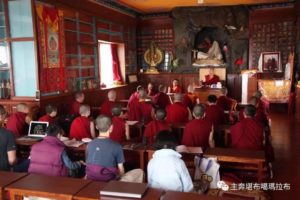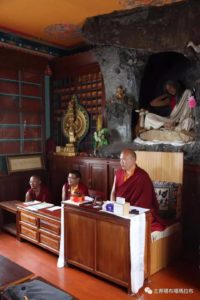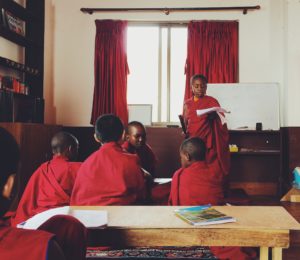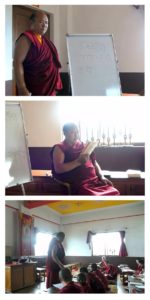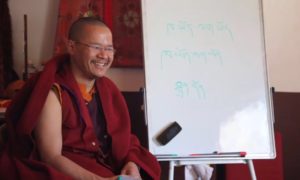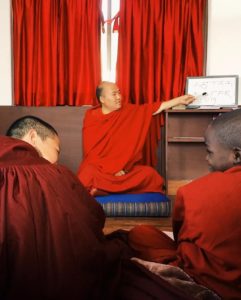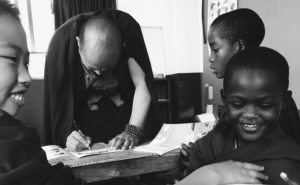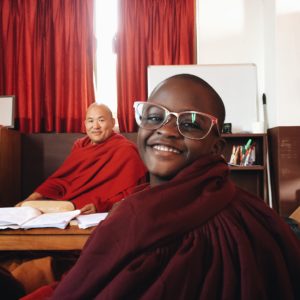Future Lotsawas in Thrangu Sekhar – Completion of Two-Year Tibetan Study Programme
On the 7th of June 2017, Drupon Khen Rinpoche initiated a two-year Tibetan study programme in Thrangu Sekhar Retreat Center in Nepal, which drew to a successful close on the 15th of July this year.
During these two years, under the guidance of Drupon Rinpoche, with Khenpo Wangchuk as the main teacher assisted by other lamas, native Tibetan speakers and senior translators, the programme provided the students with two daily classes. This is also the case with all the dharma teachings etc. in the retreat centre, the students did not need to pay anything to participate.
With great effort on both the part of the teachers and students, the rapid progress of the students soon inspired others to also learn Tibetan, including some who are in their seventies already. By the end of the two years there were more than forty students involved with the programme. The group was extremely diverse, there were African and Nepali children who came to the retreat centre to train under the guidance of Drupon Rinpoche, as well as newly arrived international adult retreatants. This meant the group had to be split into numerous different classes to accommodate the different levels and ages.
Most of the students had little or no prior study when they started, but now almost all the students can communicate with some fluency and most importantly can listen to the teachings directly themselves. Twelve of them are already acting as interpreters and have been assisting in the written translation and oral interpretation of daily teachings on The Highest Continuum (gyulama), given by Khenpo Wangchuk.
In truth the teaching of Tibetan in Sekhar started at the beginning of the six-year retreat programme in April of 2015, with Drupon Rinpoche giving a class every five days himself, starting with the alphabet. Rinpoche was always very clear with his students, that translation work is secondary; the priority is to have direct access to the dharma for the benefit of one’s own study and practice. Everyone coming to the retreat has a sincere wish to practise the dharma, but as all the texts and past lamas have taught, one must first have studied and learned something of the dharma, otherwise there is nothing to put into practice. Most of the Thrangu and visiting lamas in the retreat centre have already studied for a good number of years before coming to the retreat centre, but that is not the case for the international students. So Rinpoche, feeling responsible for giving the students the best possible chance of succeeding in the dharma, wished to give them access to the vast treasure house of sutra and tantra and their commentaries contained in the Tibetan Language, only a fraction of which is available in other languages. Rinpoche has also talked regularly about the issue of needing to rely on translators when receiving teachings from lamas; when a lama is teaching they are essentially communicating their own understanding or experience of mind, and only a translator with a similar level of understanding and experience can convey that. The translator cannot communicate what they have not understood or felt for themselves. So for those serious about taking their practice to completion, having good Tibetan truly opens the door to endless opportunities for receiving genuine dharma teachings and instructions.
Most students who took part in the programme have come to see the truth of Rinpoche’s vision and appreciate the opportunities they now have with their new language skills. With most retreatants in Sekhar now able to understand Tibetan, the plan is to gradually phase out the oral translation of teachings in the retreat centre (not including the general teachings) so that that there is more time available for some of the major treatises to be taught in full.
With the good foundation gained from the programme, the students will continue to improve their Tibetan by receiving daily dharma teachings given in Tibetan and by working with texts in their private studies. For now, the focus will shift from Tibetan studies back to the dharma teachings and practise again for the students of the programme. With a new six-year retreat programme about to start, all international retreatants will do the four daily practice sessions together, with Drupon Khen Rinpoche and Khenpo Wangchuk presiding over each session.
Alongside the primary activities of practising and receiving teachings, those whose Tibetan is of a high enough standard will join the Marpa Translation Society and begin using their skills to benefit others by undertaking the translation of some of the major Tibetan classical works, beginning with those of the Kagyu tradition. Already underway are the translation of the collected works of Gampopa, and Jamgon Kongtrul Lodro Taye’s commentary on The Highest Continuum into English, The Black Treasury – Liberation Stories of Milarepa into both English and Chinese, and the valid cognition commentary by the Seventh Karmapa, Chodrak Gyatso, Ocean of Literature on Logic. The translation of the collected works of Gampopa into Chinese will start soon too.
So it is, that after two years of hard work by both the teachers and the students, this project has come to a successful close. It has also transformed the retreat centre into a big family of practitioners from over 20 countries who can now communicate in a single language, Tibetan. The Nepali and African children that have become part of the Sekhar family will continue to have dedicated Tibetan language classes, with two Thrangu Gompa lamas in residence as their full-time tutors. Classes in English are also being given, and the African children are being taught both French and Swahili.
The hope is that from amongst the international students, and especially the children, there will emerge some genuine practitioners who are learned in both the meaning and the words, who can return to their home countries and establish the dharma authentically for the benefit of countless beings.

